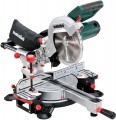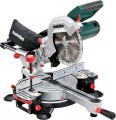Power
Saw motor power in watts. For petrol tools (see "Power Source"), horsepower is additionally indicated, see below for details.
The higher the power, the better the tool is suitable for voluminous work and hard materials, the greater the depth of cut it can provide and the easier it can cope with significant loads. In addition, for different types of saws and different types of materials, the actual power values \u200b\u200bcan also be different. For example, a power of
2.5 – 3 kW is actually the limit for
chain saws, but in
chain saws this is an average figure, among such tools there are models of
3 – 4 kW and even
more. Detailed selection recommendations for various cases can be found in special sources.
No load blade speed
The maximum speed of the disk, provided by a saw of the appropriate design — disk, cut-off, etc. (see "Device").
Note that most of these saws use gearboxes, so that the blade revolutions are much lower than the engine revolutions (see above). This achieves an increase in torque, which in the case of saws is often more important than the high speed of the blade.
As for the specific number of revolutions, it is first of all worth noting that only saws with the same disc diameter can be compared according to this indicator. In these cases, higher speeds provide better performance, but the trade-off is reduced torque; such saws do better with relatively "light" materials. Conversely, low speeds reduce productivity, but allow the blade to effectively "bite" even into dense, stubborn workpieces. More specific recommendations regarding the choice of a saw according to the number of revolutions of the blade can be found in special sources.
Features
—
Chain brake. A device that ensures the saw stops during the so-called. reverse kick. In accordance with the name, it is used in chain saw (see “Device”). Kickback can occur, in particular, when the very tip (toe) of the tire comes into contact with the material being processed. The bar and chain are thrown towards the operator, which can lead to injury. To avoid this, a chain brake is provided: during a reverse strike, it stops the saw almost instantly.
—
Anti-vibration system. Various design solutions that reduce tool vibration during operation. Strong vibrations, especially long-term ones, negatively affect the quality of work and condition of the tool, and also lead to rapid fatigue of the operator; The anti-vibration system allows to eliminate these phenomena to a certain extent.
—
Keyless chain tension. Possibility of adjusting chain tension in chain saw (see “Device”) without the use of special tools - wrenches, screwdrivers, etc. This function is especially convenient in light of the fact that during more or less long-term operation, the saw needs to be periodically checked and, if necessary, the chain must be tightened right on the spot - and this is more convenient to do without unnecessary devices.
—
Oil-free saw set. Saws that do not require additional lubrication of sawing equipment. Such models
...are unsuitable for long, productive cuts and are suitable for minor work. But the absence of the need for lubrication greatly simplifies the maintenance of the device and “keeping it in shape.”
- Smooth start. A special control system used in electric saw (see “Power source”). Without a soft start, the electric motor “starts” very abruptly, which leads to jerking of the saw and creates the risk of letting go of it. In addition, when started in this way, the tool consumes high currents, creating a significant load on the electrical network. The soft start system allows you to avoid these phenomena: the electronics limit the starting currents of the electric motor, avoiding tool jerks and voltage surges in the network.
— Electronic engine protection. A protection system that turns off power to the saw motor in the event of a critical increase in load - for example, when the disk/chain jams. Such systems are used in electric saw (see “Power source”). They help avoid damage to the unit due to overload. At the same time, we note that the electronic protection is reusable; after it is triggered and the problem is eliminated, it is enough to turn on the power again - and the saw can be used again.
— Brushless motor. The presence of a brushless (brushless) motor in an electric saw (see “Power source”). Such electric motors have a number of advantages over traditional commutator motors: in particular, they are more economical in terms of energy consumption, less noisy, and do not spark, which can be important in conditions of increased fire danger. The disadvantages of brushless motors are complexity and high cost.
— Engine brake. A device that additionally brakes the engine when the tool is turned off. The engine itself (and, accordingly, the working attachment) after switching off can still rotate for quite a long time by inertia; the brake stops this rotation almost immediately, so you don’t have to hold the tool suspended for extra time.
— Safety clutch. A device that protects the operator from sudden jerks, as well as the engine from damage due to a sharp increase in load. In such cases, the overload clutch disconnects the motor shaft, avoiding overload. Note that such devices can be either reusable or disposable - the latter are destroyed when triggered, and to continue operation you will need to install a new coupling.
— Laser marker. A kind of “target designator” that allows you to clearly determine where the cut will go. To do this, a clearly visible line is projected onto the workpiece, the location of which corresponds to the location of the future cut.
— Backlight. Lighting system built into the saw. This feature is definitely desirable when working in low light conditions. However, it can also be useful in bright external light: the place of work is often in the shadow (for example, from the tool itself), and without special lighting it can be difficult to work in such conditions.
— Speed regulator. The ability to limit the rotation speed of the saw motor (and, accordingly, the speed of the blade). This function is essentially a smooth speed control; it is especially useful in cases where full speed is not required - for example, when working with soft materials that require delicate processing.
— Maintaining speed. A function that ensures maintaining a constant engine speed (and, accordingly, a constant blade speed) regardless of the load on the tool. To do this, the tool’s automation regulates the output power depending on the current load: when the load increases, the power increases, when it decreases, it decreases. Permanent operating speed has a positive effect on both the quality of the cut and the service life of the blade and the durability of the entire tool.
— Stationary installation. Possibility of installing a portable saw (see “Type”) in a stationary manner. Most often, this feature is provided in circular saw (see “Device”), and for a stationary installation such a saw is usually turned “upside down” and fixed on a workbench or other base - thus, the sole turns into an impromptu work table. In addition, there are reciprocating saw with a similar function. In them, a stationary installation means the ability to secure the saw directly to the workpiece using a clamp - this allows you to make an even cut without the need to hold the saw suspended and constantly control its position in your hands.
— Water cooling (coolant). The saw has a water cooling system. In this case, we are talking about cooling the workpiece and the blade: water is constantly supplied to the cutting site using a special pump. Thanks to this, the heating of the blade is reduced, its service life is increased, the quality of the cut is improved and the amount of dust generated during sawing is noticeably reduced. The method of collecting water supply may be different: some models need to be connected to a water supply, others are equipped with their own water tanks. Note that water cooling is not required for sawing wood; but when working on stone, concrete and other hard and dense materials, it can be very useful.
— Keyless blade replacement. Possibility of replacing the saw blade without using wrenches, screwdrivers or other special tools. In other words, to replace the blade, the user does not have to look for an additional tool - you can open the fasteners, change the blade and secure it manually.
— Pendulum stroke. The presence of a pendulum function in the reciprocating saw (see “Device”). With this stroke, the blade, making a reverse movement, deviates slightly from the cutting line in the direction opposite to the teeth. This increases the cutting speed, reduces the heating of the blade and makes it easier to remove sawdust from the working area. At the same time, the pendulum stroke somewhat reduces the quality of the cut and is not suitable for curved lines. Therefore, this function is usually made switchable, and in some models it is also adjustable: using the switch you can change the amplitude of the pendulum.
— Display. The display shows important information about the operating modes of the saw. This can be: current strength, cutting speed, number of passes, operating time, etc. The information displayed on the screen depends on the modification of the sawing tool.
— Synchronization with a smartphone. The ability to connect the instrument with a smartphone or other gadget (for example, a tablet) via Wi-Fi or Bluetooth. The mobile application can provide information about the condition of the saw: battery charge level, temperature, etc., and proprietary software often warns the user about the need to service the tool or replace parts. Some stationary saw support remote control from a smartphone (turn on/off, adjust speed, select operating mode, configure various parameters, etc.). Finally, the mobile application can be used to set a password for starting the tool or logging work performed.
